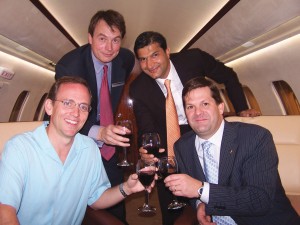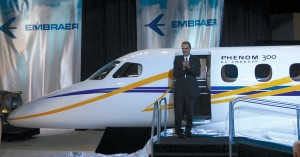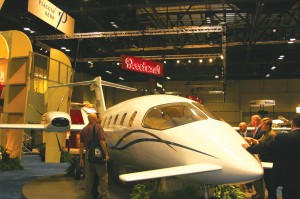By Chuck Weirauch

L to R: Linden Blue and his son, Austin Blue, unveiled the $3.65 million twin-engine Spectrum 33 composite light jet, powered by Williams FJ-33-4 turbofans, to be developed by Spectrum Aeronautical of Encinitas, Calif, with Rocky Mountain Composites, Utah
When Hurricane Katrina struck the New Orleans area this summer, the National Business Aviation Association was forced to try to move its 2005 Annual Meeting & Convention from that city to Orlando. Although there were initial fears that the storm would cause the event to be cancelled or at least diminished in its scope, the record number of exhibitors (1,142) at the event and the high attendance proved those fears to be unfounded.
The final attendance at the convention, held November 9-11 at the Orange County Convention Center in Orlando, was 27,866 show visitors. While that total wasn’t a record, it was enough to allow NBAA officials to feel confident about the potential of a successful show at the same venue in 2006.
New aircraft
The show featured many highlights, including the announcement of new aircraft and the static display of 110 other airplanes at Orlando Executive Airport that included the soon-to-be-certified Dassault Falcon 7X. On opening day at the convention center, Embraer took center stage with the unveiling of its Phenom 100 very light jet and Phenom 300 light jet.
Spectrum Aeronautical LLC took a lower-key approach that day when it announced its new Spectrum 33 high-performance business jet. Although the new airplane will be about the same cabin size as Cessna’s Citation CJ-2+, the Spectrum 33 will weigh less because of its carbon-graphite composite material construction. According to Spectrum Chairman Linden Blue, the result is a jet with a full-size cabin, better fuel efficiency and the same or better performance than its competition.
Other new aircraft announced at the convention included Bombardier’s Challenger 605 business jet and Dassault Falcon’s 2000DX.
User fee warning
The opening day ceremonies also included an overview by NBAA President Ed Bolen, an analysis of the country’s current economic status, and presentations by National Safety and Transportation Board and Transportation Security Agency representatives. Bolen warned NBAA members about the potential impact of an airport user fee system that airlines have asked the Federal Aviation Administration to implement. According to Bolen, the plan could lead to general aviation operators being priced out of the National Airspace System.
Although user fee debates have sprung up before with little consequence to the business aviation or GA communities, the new fee plan advocated by the airlines to Congress is starting to gain acceptance on Capitol Hill, Bolen said. The airlines are supporting the plan because they feel that business aviation has been taking away their first-class passengers, he explained. This system would charge all aircraft the same airport user fee, regardless of size, he pointed out. This would mean that a single-engine turboprop operator would pay the same fee as a 555-passenger Airbus 380.
“There is a growing inevitability of a user fee fight on Capitol Hill,” Bolen said. “The airlines and the Air Transportation Association are growing increasingly vocal that we’re not paying our fair share into the Airport and Airway Trust Fund.”

L to R: Piero Ferrari, president of Piaggio Aero, meets with Steven Santo, CEO of AvantAir, by a Ferrari supercar, with the new Piaggio Avanti II in the background.
Bolen assured conference attendees that the NBAA and the General Aviation Manufacturers Association would fight against the user fee, but also called for a grass-roots effort by members of the business aviation community to inform Congress of their views on the plan. To help people let their voices be heard, Bolen unveiled the NBAA’s new Contact Congress online advocacy resource. Association members can access this resource at www.nbaa.org.
Other presenters
Other speakers at the opening ceremony included Pete Bunce, GAMA CEO; Ellen Engleman Conners, NTSB chairman designate; Robert Jamison, TSA deputy administrator; and Rich Karlgaard, Forbes publisher. Both Bunce and Conners praised the reduction of GA accidents in 2004, but also called for further improvement. Bunce pointed out that GAMA is working for more NTSB resources so that every GA accident can be investigated.
Jamison said the TSA is working with the NBAA and GAMA and that their input would help guide TSA policy to keep from implementing undue restrictions on business aviation. Karlgaard said the current economic uncertainty in the United States could actually benefit business aviation, since the turbulent, unprecedented changes in top industry sectors could actually lead to new customers.
Combs award
A less controversial part of the opening ceremony was the announcement of Jay Miller, author of “X-Planes,” volumes I and II, as the winner of the third annual Harry B. Combs Award. National Hall of Fame Executive Director Ron Kaplan presented Miller a $20,000 check. Assisting with the presentation were X-plane program test pilots and contributors Scott Crossfield, Bob Hoover and astronaut Capt. Eugene Cernan. All three are enshrined in the NAHF.
Special sessions
More than 70 special sessions and seminars were held during the course of the three-day conference. Some of the topics covered during these events included aviation insurance and risk management, maintenance training, security, air traffic control management, VLJ progress and future, the Small Aircraft Transportation System and the Next Generation Air Transportation System.
The high level of interest in VLJs at the convention was reflected in the packed-to-the-walls session on that topic. The session began with a panel comprised of top VLJ aircraft manufacturers, including Vern Raburn of Eclipse Aviation, Rick Adam of Adam Aircraft, Phil Michel of Cessna, Luis Carlos Affonso of Embraer and George Bye of the company building the Javelin business jet, Aviation Technology Group.
Raburn, now with orders for more than 2,300 Eclipse 500 VLJs, said the new aircraft class would have a significant impact on aviation. Cessna’s Mustang is about to be certified, and Michel agreed with Raburn that it’s just a question of when that effect will be felt. Adam predicted that over the next 10 years there will be more demand for VLJs than existing manufacturers can provide.

L to R: Sherman Rogers, the first Challenger 605 customer, celebrates the announcement of the new aircraft with James Hoblyn, VP of Bombardier Business Aircraft; Jahid Fazal-Karim, senior VP of new aircraft sales, Bombardier Business Aircraft; and Pierre













